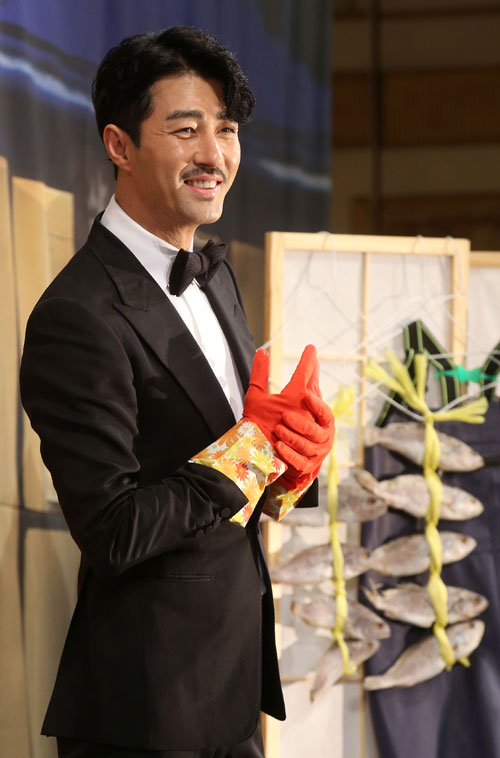- California Assembly OKs highest minimum wage in nation
- S. Korea unveils first graphic cigarette warnings
- US joins with South Korea, Japan in bid to deter North Korea
- LPGA golfer Chun In-gee finally back in action
- S. Korea won’t be top seed in final World Cup qualification round
- US men’s soccer misses 2nd straight Olympics
- US back on track in qualifying with 4-0 win over Guatemala
- High-intensity workout injuries spawn cottage industry
- CDC expands range of Zika mosquitoes into parts of Northeast
- Who knew? ‘The Walking Dead’ is helping families connect
Men cooking mesmerize Korean TV watchers in still male-dominated society

In this file photo taken on Jan. 9, 2015, actor Cha Seung-won poses with red rubber globes during a press conference for “Samsi Sekki.” Cha has emerged as one of the male cooks at the forefront of the “cooking men” craze. (Yonhap)
SEOUL, June 29 (Yonhap) — Men cooking are the newest fixture on the Korean TV scene.
Following a whirlwind of reality shows depicting the glamorous lives of celebrities rearing their offspring, attention has now shifted to men cooking up dishes, ranging from simple recipes like fried kimchi rice to creative concoctions such as fried cream cheese topped with seedless grape and served with strawberry jam and balsamic vinegar.
While big-name male chefs such as Gordon Ramsay and Jamie Oliver have long flaunted their cooking skills in the global entertainment industry, the current fad is relatively new in South Korea where mother-like female chefs used to dominate TV cooking shows.
Actor Cha Seung-won is among the new breed of men who have won the heart of TV watchers with his solid cooking.
The 45-year-old, known for his charismatic and masculine acting, awed watchers by deftly churning up fried fish cake and seafood pizza in a makeshift seaside kitchen during the episodes of “Samsi Sekki,” a reality show whose title translates to “three daily meals.”
His superb cooking eventually earned him the nickname, “Chajumma,” a compound of his family name Cha and the Korean word “ajumma,” which refers to married middle-aged women who are seasoned homemakers. Buoyed by the newfound image, Cha has won endorsement deals from major food and beverage makers, including fast-food chain Lotteria and noodle maker Paldo.
Restaurant franchise entrepreneur Paik Jong-won is another star leading the pack of male cuisiniers. Once better known as actress So Yoo-jin’s husband, he has now built up a sturdy fandom on the back of his affable demeanor and easy-to-follow recipes for cooking novices.
In fact, his popularity is soaring at such a blistering pace that Google searches of him have outnumbered those of President Park Geun-hye at a time when the country is tackling the MERS outbreak. An index gauging the search frequency of their names showed that Paik’s name reached 20, topping Park’s 5 in May, according to Google Trends.
While Olive TV, a lifestyle channel run by conglomerate CJ, had previously aired survival-type cooking shows starring cooks of both genders, the focus has now substantially gravitated to male chefs. A popular series by cable channel JTBC, for instance, centers around eight male chefs vying to invent authentic dishes in 15 minutes.
The newfound craze surrounding male cooks has encouraged men to head to the kitchen, an area that is still largely managed by women even in modern day Korea.
Ahn Ji-hoon is one of them. The 29-year-old took up cooking classes with two other male colleagues after watching episodes of “Samsi Sekki.”
“I wasn’t interested in cooking at all. But after seeing male celebrities cooking, I wanted to master at least one or two special dishes,” he said, adding that he has cooked up dishes like deep-fried shrimp with spicy sauce for his family after taking the lesson.
The Seoul office worker is not alone. Market data indicate a rise in interest in cooking among Korean men.
G Market saw purchases of kitchen utensils by male shoppers jump 31 percent on-year in the past month, with their sales accounting for nearly one-third of the total. AK Mall, another online shopping mall, reported a 130 percent spike in sales of kitchen utensils and dishware in the male segment in February, compared with a 36 percent rise in the female segment.
Food and beverage makers view the trend as an opportunity to bolster marketing. CJ Cheiljedang, for instance, opened cooking classes exclusively for men, with three streams targeting single men, married men and one dedicated to working fathers and their children.
“The cooking class was our first attempt to apply the emerging trend of men cooking. It was a huge success, with applications reaching 10-fold of the available spots in some cases,” said Kim Min-kyung, a CJ Cheiljedang official who launched the classes, adding the company plans to provide additional classes going forward.
Trend watchers and sociologists say the “men cooking” phenomenon may offer a glimpse into the Korean society where traditional gender roles are changing as women are increasingly becoming breadwinners and subsequently redefining conventional household roles with their partners.
South Korea has seen a sharp rise in the women labor force in the past years, which has expanded the social and economic boundaries of women. In 2014, the portion of economically active women and the female employment rate soared to a record high of 51.3 percent and 49.5 percent each.
“It’s a matter of survival for men. Men are starting to realize that a concrete divide in traditional gender roles can actually become a disadvantage, which is why they are also trying to expand their roles,” said Lee Na-Young, a sociology professor at Chung-ang University in Seoul.
“Longer life expectancy means that men have to stay at home for a longer time after retirement. It’s an issue that many men fret about and for them, cooking is one way to overcome that anxiety,” she added, explaining that cooking can help them bond with their families as well as cater to their everyday need for eating.
But at the same time, some say that the buzz may ironically represent persistent hurdles facing Korean women in a society where C-suite jobs are dominated by men and gender pay gaps are the biggest among member countries of the Organization for Economic Cooperation and Development.
“I don’t think gender roles at home have really changed. But at least when I see male chefs cooking, I feel that it is not a menial household chore. It becomes something professional,” said Hwang Soo-young, a 30-year-old female fan of those cooking shows.
Cynthia Yoo, a contributor to lifestyle media luv.kr, who writes about the Korean food and media scene, said the growing popularity of these shows is likely to be confined to the entertainment industry.
“Most people watch these shows to be entertained. I’m not sure if these shows reflect wider social changes. In most households, women still do the cooking and only a few men bother to help out,” she said, partly attributing the recent craze to a change in audience demographics.
While stay-at-home wives who want to learn cooking were the main audience in the past, the watchers have expanded into a bigger group that includes one-person households and single men, who deem cooking as a weekend or after-work leisure activity, according to Yoo.
But at least for the culinary novice Ahn, those TV shows were what kindled his interest in cooking and household work.
“I’m not sure if the trend will prompt men who didn’t do any household work to start doing so. But these programs will make them start cooking at least on the weekends. As for me, I plan to share cooking and cleaning chores with my future partner.”
















Pingback: Changes - Posie on the Lamb
episodes
August 29, 2017 at 8:10 PM
Mp3 Songs Downloader – CNET Download – Free …